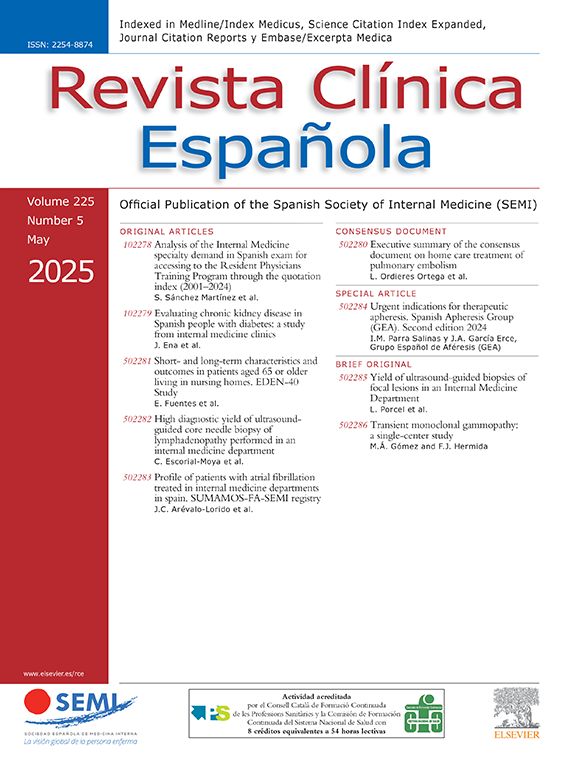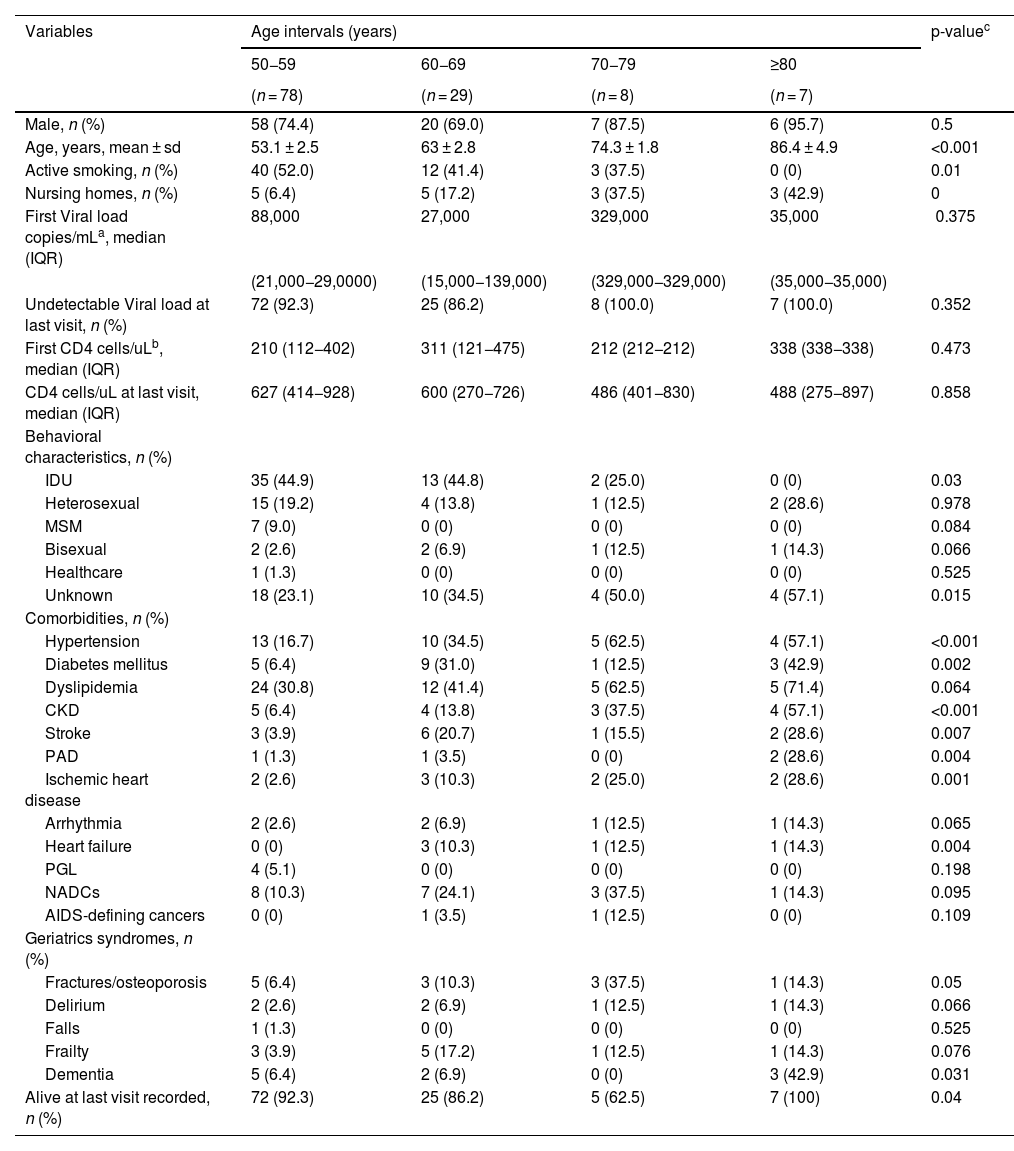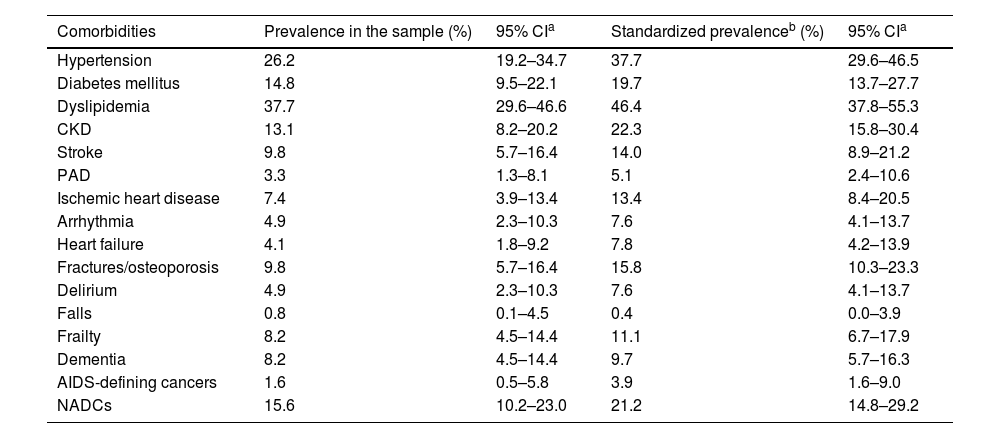People living with HIV (PLHIV) are at increased risk of multimorbidity compared to the general population. The goal of this study is to evaluate the prevalence of non-infectious comorbidities and geriatric syndromes in PLHIV ≥ 50 years old.
MethodsA cross-sectional analysis was conducted on a cohort of PLHIV regularly followed at an outpatient clinic in a University Hospital in Spain, focusing on PLHIV aged 50 and above. Participants were categorized by age into ten-year intervals. Crude and standardized prevalence of each comorbidity and its trend across age groups were estimated. The prevalence of multimorbidity (≥2 diseases) was also evaluated. All prevalence were estimated with the exact method.
ResultsWe evaluated 122 PLHIV, of which 25.4% were women and 13% resided in nursing homes. The median time between HIV diagnosis and the last documented visit was 19 (9–29) years. Overall prevalence of multimorbidity was 37% (95% CI 28.4 %–45.6 %), being the most prevalent comorbidities cardiovascular risk factors dyslipidemia (37.7%; 95% CI 29.6 %–46.6 %), hypertension (26.2%; 95% CI: 19.2 %–34.7 %), diabetes mellitus (14.8%; 95% CI: 9.5 %–22.1 %) and non-AIDS defining cancers (15.6%; 95% CI: 10.2 %–23.0 %). The most common geriatric syndromes were fractures/osteoporosis (9.8%; 95% CI: 5.7 %–16.4 %), dementia (8.2%; 95% CI: 4.5–14.4 %) and frailty (8.2%; 95% CI: 4.5–14.4 %). The prevalence of most comorbidities and multimorbidity showed a significantly increasing trend across age groups.
ConclusionsPLHIV who are over 50 years of age have a high prevalence of non-infectious comorbidities and geriatric syndromes. Multimorbidity increases with age in this population group.
Las personas que viven con VIH (PLHIV, por sus siglas en inglés: people living with HIV) tienen un mayor riesgo de multimorbilidad en comparación con la población general. El objetivo de este estudio es evaluar la prevalencia de comorbilidades no infecciosas y síndromes geriátricos en PLHIV mayores de 50 años.
MétodosSe realizó un análisis transversal en una cohorte de PLHIV atendida regularmente en una clínica ambulatoria de un hospital universitario en España, centrándose en PLHIV de 50 años o más. Los participantes se categorizaron por edad en intervalos de diez años. Se estimaron la prevalencia cruda y estandarizada de cada comorbilidad y su tendencia según los grupos de edad. También se evaluó la prevalencia de multimorbilidad (>2 enfermedades). Todas las prevalencias se estimaron mediante el método exacto.
ResultadosSe evaluaron 122 PLHIV, de los cuales el 25,4% eran mujeres y el 13% residían en hogares de ancianos. El tiempo mediano entre el diagnóstico de VIH y la última visita documentada fue de 19 (9–29) años. La prevalencia general de multimorbilidad fue del 37% (IC 95%: 28,4%–45,6%), siendo las comorbilidades más prevalentes los factores de riesgo cardiovascular: dislipidemia (37,7%; IC 95%: 29,6%–46,6%), hipertensión arterial (26,2%; IC 95%: 19,2%–34,7%), diabetes mellitus (14,8%; IC 95%: 9,5%-22,1%) y cánceres no definitorios de sida (15,6%; IC 95%: 10,2%–23,0%). Los síndromes geriátricos más comunes fueron fracturas/osteoporosis (9,8%; IC 95%: 5,7%–16,4%), demencia (8,2%; IC 95%: 4,5%–14,4%) y fragilidad (8,2%; IC 95%: 4,5%–14,4%). La prevalencia de la mayoría de las comorbilidades y la multimorbilidad mostró una tendencia significativamente creciente con la edad.
ConclusionesLas personas que viven con VIH mayores de 50 años tienen una alta prevalencia de comorbilidades no infecciosas y síndromes geriátricos. La multimorbilidad aumenta con la edad en este grupo poblacional.
Article
Diríjase desde aquí a la web de la >>>FESEMI<<< e inicie sesión mediante el formulario que se encuentra en la barra superior, pulsando sobre el candado.

Una vez autentificado, en la misma web de FESEMI, en el menú superior, elija la opción deseada.

>>>FESEMI<<<








